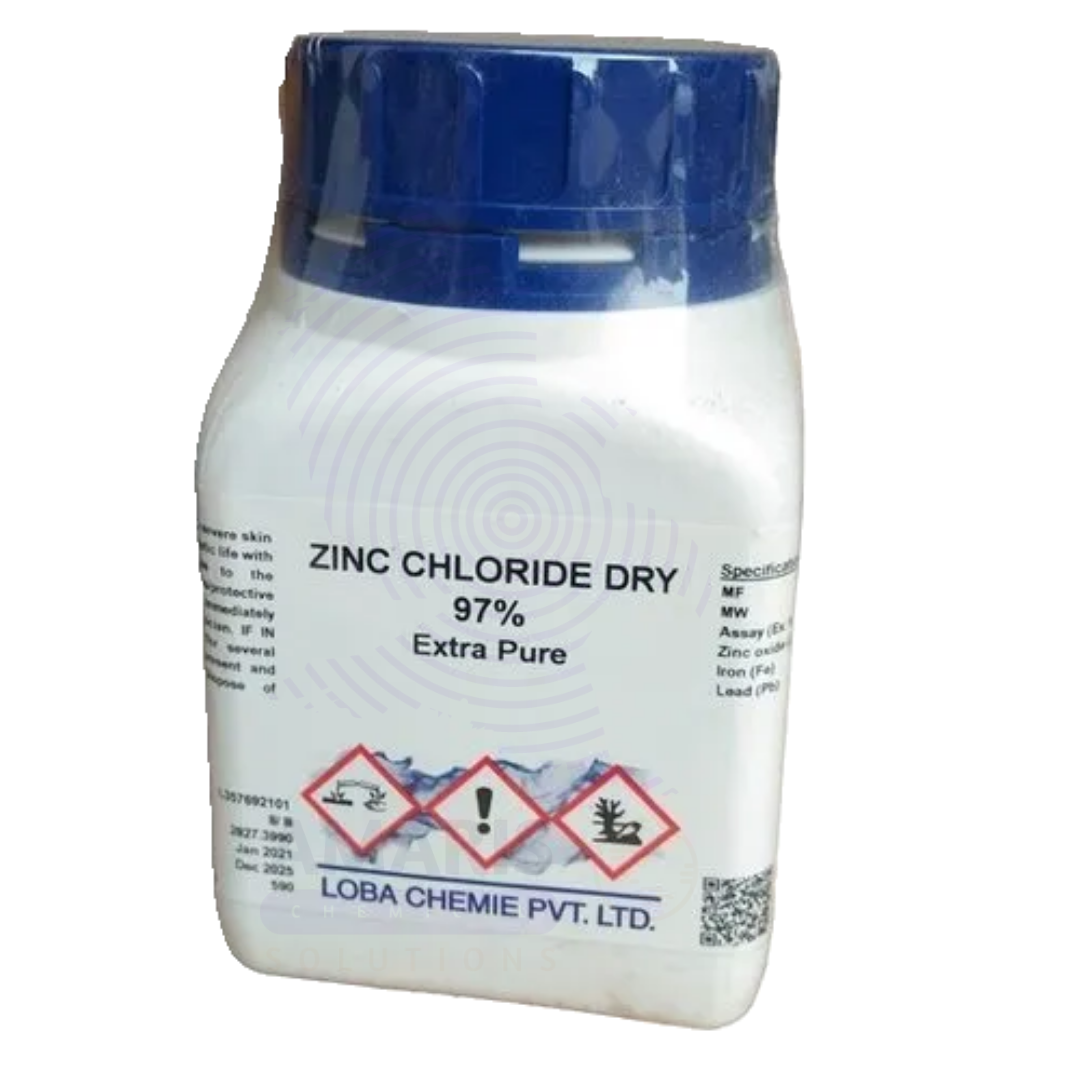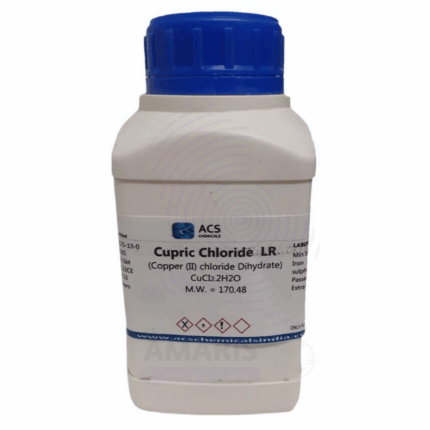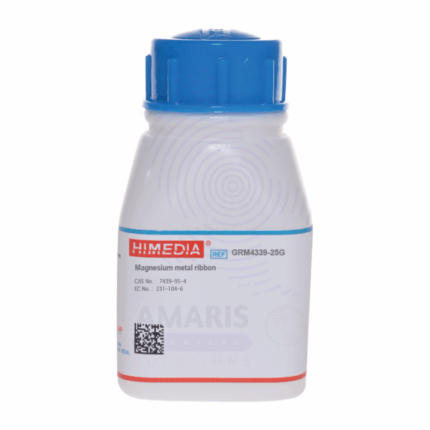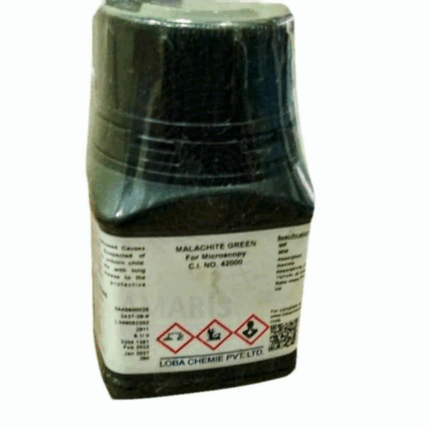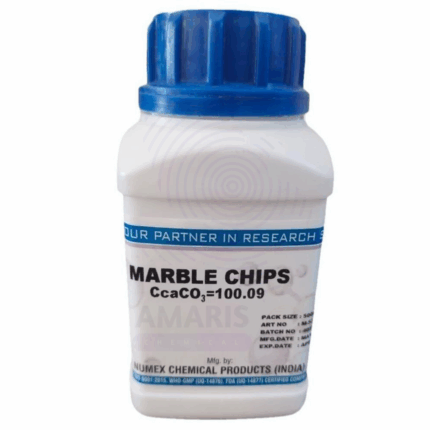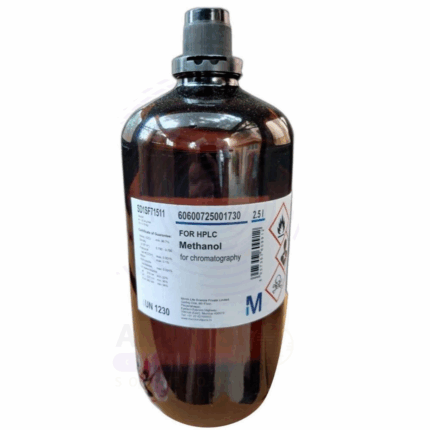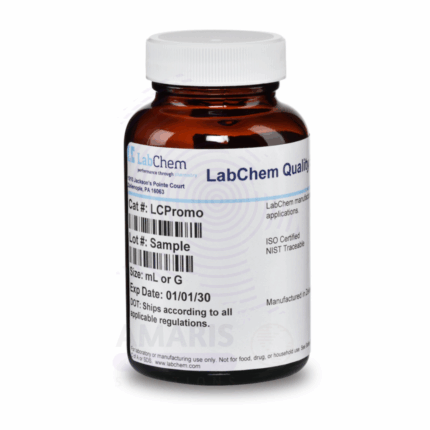

Zinc Chloride Extra Pure
$ 18.11 Original price was: $ 18.11.$ 17.98Current price is: $ 17.98.
Zinc Chloride Extra Pure is a highly pure, white crystalline or granular inorganic compound with formula ZnCl₂. It is a powerful Lewis acid and widely utilized in laboratories as a reagent, catalyst, and analytical standard. Due to its high solubility and acidity in water, it serves important roles in chemical synthesis, textile processing, and metallurgical fluxes. In pharmaceuticals and cosmetics, it is valued for its antiseptic and astringent properties. Industrially, Zinc Chloride is employed in water treatment, adhesives, and coatings. Because of its corrosive nature and reactivity with moisture, it requires careful handling and storage under dry conditions with appropriate personal protective equipment. Its environmental impact requires controlled disposal due to aquatic toxicity.
Zinc Chloride Extra Pure
PRIMARY USES
- Analytical Reagent & Laboratory Applications:
- Widely used as a reagent in chemical analysis and synthesis
- Acts as a catalyst in organic and inorganic reactions
- Employed in qualitative and quantitative zinc assays
- Used in preparation of other zinc salts and complexes
- Important in buffer solutions and pH adjustment in lab procedures
- Pharmaceutical & Cosmetic Industry:
- Utilized as an astringent and antiseptic in topical pharmaceutical formulations
- Ingredient in various personal care products for skin conditioning
- Used in dental applications for its antiseptic properties
- Industrial & Chemical Manufacturing:
- Key component in textile processing for fabric treatment and dye fixation
- Used in metallurgical fluxes for soldering and galvanizing
- Employed in chemical manufacturing of adhesives, coatings, and preservatives
- Used in water treatment for pH adjustment and as a corrosion inhibitor
SECONDARY USES
- Agricultural Chemicals:
- Source of zinc micronutrient in fertilizers and soil conditioners
- Food Industry:
- Occasionally used in food packaging and as a preservative in regulated quantities
- Environmental Applications:
- Utilized in wastewater treatment to remove impurities and heavy metals
1. Basic Identification Attributes
Chemical Name: Zinc Chloride
CAS Number: 7646-85-7
HS Code: 2827.39.00
Molecular Formula: ZnCl₂
Synonyms:
- Zinc bichloride
- Butter of zinc
2. Physical & Chemical Properties
Physical State: Crystalline solid or granular
Color & Odor: White to pale yellow, odorless or slight chlorine-like odor
Melting Point: 290 °C (decomposes)
Boiling Point: 732 °C (sublimes)
Density/Specific Gravity: 2.907 g/cm³
Solubility:
- Highly soluble in water (432 g/100 mL at 20 °C)
- Soluble in alcohol and glycerol
pH Level: Strongly acidic when dissolved in water (pH ~1-2 for concentrated solutions)
Vapor Pressure & Volatility: Low volatility but releases corrosive fumes upon heating
Flash Point: Not applicable (non-flammable)
Autoignition Temperature: Not applicable
Viscosity: Not applicable
3. Safety & Hazard Attributes
Hazard Class (GHS Classification):
- Corrosive to skin and eyes (Category 1B)
- Harmful if swallowed or inhaled
NFPA Ratings: - Health: 3
- Flammability: 0
- Reactivity: 1
Exposure Limits: - OSHA PEL: 1 mg/m³ (as Zn)
- ACGIH TLV: 2 mg/m³ (as Zn)
Reactivity: - Reacts violently with water releasing heat and hydrochloric acid vapors
- Reacts with strong bases to form zinc hydroxide precipitates
4. Storage & Handling Attributes
Storage Conditions:
- Store in tightly sealed containers in a cool, dry, and well-ventilated area
- Protect from moisture and incompatible substances
Incompatible Materials: - Strong oxidizing agents
- Strong bases
- Water and moisture (release of heat and corrosive fumes)
Container Type: - Plastic or glass containers with corrosion-resistant linings
Shelf Life & Expiration Date: - Stable if stored properly, typically several years
Special Handling Requirements: - Use acid-resistant gloves, face shield, and protective clothing
- Work in fume hood or well-ventilated environment
5. Regulatory & Compliance Attributes
Regulatory Status:
- Approved for pharmaceutical and industrial applications with restrictions
- Listed in REACH, OSHA, EPA, and other chemical inventories
Transportation Restrictions: - Classified as corrosive material for transport
Waste Disposal Method: - Dispose in accordance with hazardous waste regulations
6. Environmental & Health Impact
Ecotoxicity:
- Toxic to aquatic life with long-lasting effects
Persistence in Environment: - Breaks down in water but may cause localized acidity
Carcinogenicity/Mutagenicity: - Not classified as carcinogenic or mutagenic
Biodegradability: - Inorganic; does not biodegrade but dilutes in environment
SAFETY PRECAUTIONS
Personal Protective Equipment (PPE):
- Acid-resistant gloves and clothing
- Chemical safety goggles or face shield
- Respiratory protection if dust or fumes are present
Handling:
- Avoid inhalation of dust and fumes
- Prevent skin and eye contact
- Use in well-ventilated area or fume hood
- Wash hands thoroughly after handling
Storage:
- Store away from water, bases, and oxidizers
- Keep containers tightly closed and protected from moisture
FIRST AID MEASURES
Inhalation:
- Move to fresh air immediately
- Seek medical attention if respiratory symptoms develop
Skin Contact:
- Rinse affected area with plenty of water for at least 15 minutes
- Remove contaminated clothing
- Seek immediate medical attention for burns or severe irritation
Eye Contact:
- Flush eyes with water for at least 15 minutes
- Seek emergency medical care promptly
Ingestion:
- Do not induce vomiting
- Rinse mouth with water
- Seek immediate medical attention
FIRE FIGHTING MEASURES
Flammability:
- Non-flammable but may release toxic fumes when heated
Extinguishing Media: - Use water spray, foam, dry chemical, or CO₂
Hazardous Combustion Products: - Hydrochloric acid vapors and zinc oxide fumes
Firefighter Protection: - Wear full protective gear and self-contained breathing apparatus


 Preservatives(food)
Preservatives(food) Flavor Enhancers
Flavor Enhancers Acidulants
Acidulants Sweeteners
Sweeteners Antioxidants
Antioxidants Colorants(food)
Colorants(food) Nutraceutical Ingredients (food)
Nutraceutical Ingredients (food) Nutrient Supplements
Nutrient Supplements Emulsifiers
Emulsifiers
 Collectors
Collectors Dust Suppressants
Dust Suppressants Explosives and Blasting Agents
Explosives and Blasting Agents Flocculants and Coagulants
Flocculants and Coagulants Frothers
Frothers Leaching Agents
Leaching Agents pH Modifiers
pH Modifiers Precious Metal Extraction Agents
Precious Metal Extraction Agents
 Antioxidants(plastic)
Antioxidants(plastic) Colorants (Pigments, Dyes)
Colorants (Pigments, Dyes) Fillers and Reinforcements
Fillers and Reinforcements Flame Retardants
Flame Retardants Monomers
Monomers Plasticizers
Plasticizers Polymerization Initiators
Polymerization Initiators Stabilizers (UV, Heat)
Stabilizers (UV, Heat)
 Antifoaming Agents
Antifoaming Agents Chelating Agents
Chelating Agents Coagulants and Flocculants
Coagulants and Flocculants Corrosion Inhibitors
Corrosion Inhibitors Disinfectants and Biocides
Disinfectants and Biocides Oxidizing Agents
Oxidizing Agents pH Adjusters
pH Adjusters Scale Inhibitors( water)
Scale Inhibitors( water)
 Antioxidants(cosmetic)
Antioxidants(cosmetic) Emollients
Emollients Fragrances and Essential Oils
Fragrances and Essential Oils Humectants
Humectants Preservatives
Preservatives Surfactants(cosmetic)
Surfactants(cosmetic) Thickeners
Thickeners UV Filters
UV Filters
 Fertilizers
Fertilizers Soil Conditioners
Soil Conditioners Plant Growth Regulators
Plant Growth Regulators Animal Feed Additives
Animal Feed Additives Biostimulants
Biostimulants Pesticides (Herbicides, Insecticides, Fungicides)
Pesticides (Herbicides, Insecticides, Fungicides)
 Active Pharmaceutical Ingredients (APIs)
Active Pharmaceutical Ingredients (APIs) Excipients
Excipients Solvents(pharmaceutical)
Solvents(pharmaceutical) Antibiotics
Antibiotics Antiseptics and Disinfectants
Antiseptics and Disinfectants Vaccine Adjuvants
Vaccine Adjuvants Nutraceutical Ingredients (pharmaceutical)
Nutraceutical Ingredients (pharmaceutical) Analgesics & Antipyretics
Analgesics & Antipyretics
 Analytical Reagents
Analytical Reagents Solvents(lab)
Solvents(lab) Chromatography Chemicals
Chromatography Chemicals Spectroscopy Reagents
Spectroscopy Reagents microbiology-and-cell-culture-reagents
microbiology-and-cell-culture-reagents Molecular Biology Reagents
Molecular Biology Reagents Biochemical Reagents
Biochemical Reagents Inorganic and Organic Standards
Inorganic and Organic Standards Laboratory Safety Chemicals
Laboratory Safety Chemicals Specialty Laboratory Chemicals(Special Laboratory Equipment)
Specialty Laboratory Chemicals(Special Laboratory Equipment)
 Demulsifiers
Demulsifiers Hydraulic Fracturing Fluids
Hydraulic Fracturing Fluids Scale Inhibitors(oil)
Scale Inhibitors(oil) Surfactants(oil)
Surfactants(oil) Drilling Fluids
Drilling Fluids
 Dyes and Pigments
Dyes and Pigments Bleaching Agents
Bleaching Agents Softening Agents
Softening Agents Finishing Agents
Finishing Agents Antistatic Agents
Antistatic Agents
 Admixtures
Admixtures Waterproofing Agents
Waterproofing Agents Sealants and Adhesives
Sealants and Adhesives Curing Compounds
Curing Compounds Concrete Repair Chemicals
Concrete Repair Chemicals Anti-Corrosion Coatings
Anti-Corrosion Coatings
 Surfactants(cleaning)
Surfactants(cleaning) Builders
Builders Enzymes
Enzymes Solvents (Cleaning)
Solvents (Cleaning) Fragrances
Fragrances
 Electronic Chemicals
Electronic Chemicals Catalysts
Catalysts Lubricants
Lubricants Photographic Chemicals
Photographic Chemicals Refrigerants
Refrigerants Automotive chemicals
Automotive chemicals Pyrotechnic Chemicals
Pyrotechnic Chemicals
 Biodegradable Surfactants
Biodegradable Surfactants Bio-based Solvents
Bio-based Solvents Renewable Polymers
Renewable Polymers Carbon Capture Chemicals
Carbon Capture Chemicals Wastewater Treatment Chemicals
Wastewater Treatment Chemicals
 Pigments
Pigments Solvents(paint)
Solvents(paint) Specialty Coatings
Specialty Coatings Binders/Resins
Binders/Resins Additives
Additives Driers
Driers Anti-Corrosion Agents
Anti-Corrosion Agents Functional Coatings
Functional Coatings Application-Specific Coatings
Application-Specific Coatings
 Fresh Herbs
Fresh Herbs Ground Spices
Ground Spices Whole Spices
Whole Spices Spice Blends
Spice Blends Dried Herbs
Dried Herbs
 Leavening Agents
Leavening Agents Dough Conditioners
Dough Conditioners Flour Treatments
Flour Treatments Fat Replacers
Fat Replacers Decoratives
Decoratives Preservatives(baking)
Preservatives(baking)
 Plasticizers & Softeners
Plasticizers & Softeners Reinforcing Agents
Reinforcing Agents Adhesion Promoters
Adhesion Promoters Vulcanizing Agents
Vulcanizing Agents Antidegradants
Antidegradants Blowing Agents
Blowing Agents Fillers & Extenders
Fillers & Extenders Accelerators & Retarders
Accelerators & Retarders